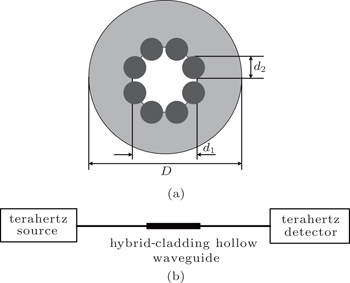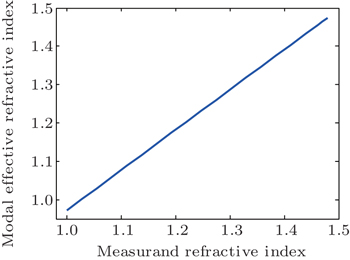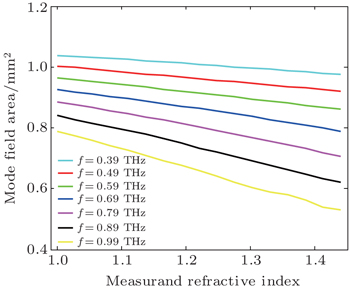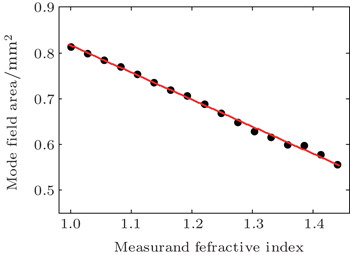† Corresponding author. E-mail:
Project supported by the National Natural Science Foundation of China (Grant No. 51309059).
We propose a design of terahertz refractive index sensing based on the multi-metal-wire (MMW) hybrid-cladding hollow waveguide. The proposed terahertz hybrid-cladding hollow waveguide comprises one air core in the center surrounding MMW surrounded dielectric. The central air core is used for filling lossless measurands and transmitting terahertz light. In particular, the refractive index sensing is realized by measuring the mode field area (MFA) variation of radially polarized mode. The modal effective refractive index, mode field intensity distribution, and mode field area properties responding to the measurand refractive indexes for different operating frequencies and structure dimensions are investigated, respectively. Simulations show that the proposed terahertz refractive index sensor can realize easily the measurement of the measurand refractive index. Meanwhile, the effects of operating frequency and structure parameters on sensitivity and measurement accuracy are also studied. In view of the trade-off between sensitivity and measurement accuracy, the reasonable choice of the operating frequency and structure parameters can optimize appropriately the sensitivity and measurement accuracy, and the sensitivity can reach approximately 0.585 mm2/RIU (RIU is short for refraction index units) with the proper frequency and structure parameter.
Terahertz (THz) radiation technologies have drawn increasing attention in recent years due to its unique properties compared with other wavelength bands, and significant potential applications in many areas such as sensing,[1–3] communication,[4–6] and imaging,[7–9] etc. THz waveguide technology is also vital to the improvement of THz technology due to its potential ability to construct low loss and robust THz integrated systems.[10–12] To date, THz waveguide composed of a variety of dielectrics/metals has been demonstrated. THz dielectric waveguides include dielectric ribbon waveguide,[13] dielectric subwavelength fibers,[14] and dielectric hollow core waveguide.[15] However, because of high losses of dielectric materials in the terahertz range, metal-based THz waveguides have also been reported including metal wire waveguide,[16] hollow metallic waveguide,[17] and parallel plate metallic waveguide.[18] Nevertheless, metal-based THz waveguide suffers bend and diffraction losses to some extent, which restricts the application of metal-based THz waveguide. Therefore, hybrid structure waveguide methods combining the merits of metal waveguide and dielectric waveguide have continued to develop over the past several years.[19–21]
Recently, there has been an increasing interest in waveguide for parametric sensing (refractive index and strain sensing, etc.), due to its important applications in biochemistry and medicine. THz waveguide parametric sensor has also been extensively applied to bio-sensing filed because of the characteristics of low photonic energy and multiple frequency spectrum of THz radiation. Recently, a variety of THz waveguide parametric sensors were proposed and demonstrated, such as mechanically tunable metamaterial sensors,[22] photonic crystal waveguide sensors,[23–25] dielectric pipe waveguide sensors,[26] and hybrid plasmonic waveguide refractive index sensors,[27] which can realize effectively the measurement of the analyte refractive index.
In the present paper, a new type of THz waveguide refractive index sensor based on the multi-metal-wire hybrid-cladding hollow waveguide is proposed and demonstrated. Unlike the previously reported THz waveguide refractive index sensor, the proposed sensor detects the variation of mode field area in response to the changes of the measurand refractive index. For the different frequencies and structure dimensions of the proposed THz sensor, the variations of mode field area with measurand refractive index are investigated numerically. In addition, the variations of sensitivity and accuracy with frequency and geometric dimension of the device are also analyzed. The proposed THz waveguide refractive index sensor can be potentially applied to the detection of various gaseous measurands.
The THz hybrid-cladding hollow waveguide considered here is a structure with multi-metal-wires inserted into the internal junction of the hollow dielectric waveguide. Figure
Firstly, we comparatively study how our proposed multi-metal-wire hybrid-cladding hollow waveguide differs from a metallic inner coating (MIC) hollow dielectric waveguide. Here, the air core diameter d1, the metallic wire diameter d2, the dielectric cladding diameter D, and the operating frequency are assumed to be 1.60 mm, 0.49 mm, 4.00 mm, and 0.69 THz respectively. Note that the parameters of the proposed THz waveguide are fixed unless otherwise stated. We assume here that the MIC has geometry dimensions comparable to those of our proposed MMW. That is, the dielectric cladding diameter D = 4.00 mm, and the air core diameter d1 = 1.6 mm. Besides, the metallic inner film thickness is assumed to be 0.245 mm (which is equal to the radius of metallic wire). In order to realize the measurement of the refractive index of measurand simply and intuitively, we introduce the lossless measurands into the comparatively large air core of hybrid-cladding hollow waveguide, when the THz beam is launched into the central air core, which leading to the fact that mode field area varies with the refractive index of measurand. This mode field area Aeff can be calculated according to[30]

Figure
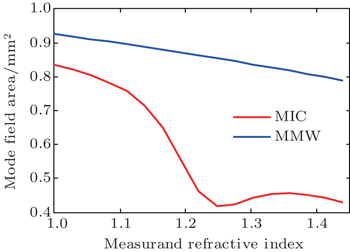 | Fig. 2. Variations of mode field area with measurand refractive index of MIC and MMW hollow waveguide. |
Figure
 | Fig. 3. Mode field intensity distributions of the proposed THz waveguide at frequencies of (a) 0.39 THz, (b) 0.69 THz, and (c) 0.99 THz. |
Figure
Next, we examine how the measurand refractive index influences mode field intensity distribution of the proposed THz waveguide. Figure
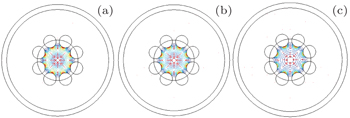 | Fig. 5. Mode field intensity distributions of the proposed THz waveguide at the refractive indexes of measurand of (a) 1.00, (b) 1.22, and (c) 1.44. |
From the above discussion, we consider the relation between the mode field area and the refractive index of measurand. For different frequencies, variations of mode field area with the measurand refractive indexes are shown in Fig.
In the above analyses, we only consider the case of fixed geometry dimensions. In the following, we will further analyze the variation relation between the mode field area and the measurand refractive index for different metallic wire diameters and air core diameters. Figure
 | Fig. 7. Variations of mode field area with measurand refractive index for different values of metallic wire diameter d2. |
Figure
 | Fig. 8. Plot of mode field area versus measurand refractive index for different values of air core diameter d1. |
From the above analyses, we can find that the operating frequency has a greater effect on the sensitivity of the sensor, and the structure parameters have lesser effects on the sensitivity of the sensor. However, the structure parameters have greater effects on the measurement accuracy when the measurand refractive index is relatively large. As a result, considering the sensitivity and the measurement accuracy simultaneously, we select a THz waveguide structure with modest structure parameters and operating frequency, i.e., the air core diameter d1 = 1.50 mm, metallic wire diameter d2 = 0.49 mm, and operating frequency f = 0.89 THz. Figure
In this paper, we propose and demonstrate a new kind of terahertz refractive index sensor based on multi-metal-wire hybrid-cladding hollow waveguide. Unlike the previously reported THz waveguide refractive index sensor, the proposed sensor measures the variation relation between the mode field area and the refractive index of the measurand. By the finite element method, the modal effective refractive index, mode field intensity distribution, and mode field area versus the measurand refractive index with different frequencies and waveguide structure dimensions are investigated. In addition, the variation of sensitivity with the geometric dimension of the device is also analyzed. Results show that the proposed THz refractive index sensor can achieve easily the measurement of the measurand refractive index, and the reasonable choices of the operating frequency and structure parameters can optimize appropriately the sensitivity and measurement accuracy. Through the demonstration of the measuand refractive index range, we can find that the proposed THz waveguide refractive index sensor is of potential application to detecting various gaseous measurands.
| 1 | |
| 2 | |
| 3 | |
| 4 | |
| 5 | |
| 6 | |
| 7 | |
| 8 | |
| 9 | |
| 10 | |
| 11 | |
| 12 | |
| 13 | |
| 14 | |
| 15 | |
| 16 | |
| 17 | |
| 18 | |
| 19 | |
| 20 | |
| 21 | |
| 22 | |
| 23 | |
| 24 | |
| 25 | |
| 26 | |
| 27 | |
| 28 | |
| 29 | |
| 30 |



